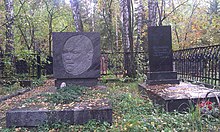Anatoly Maltsev

Anatoly Ivanovich Maltsev (also: Malcev, Mal'cev;
Biography
At school, Maltsev demonstrated an aptitude for mathematics, and when he left school in 1927, he went to Moscow State University to study Mathematics. While he was there, he started teaching in a secondary school in Moscow. After graduating in 1931, he continued his teaching career and in 1932 was appointed as an assistant at the Ivanovo Pedagogical Institute located in Ivanovo, near Moscow.
Whilst teaching at Ivanovo, Maltsev made frequent trips to Moscow to discuss his research with
In 1937, Maltsev published a paper on the embedding of a ring in a field. Two years later, he published a second paper where he gave necessary and sufficient conditions for a semigroup to be embeddable in a group.
Between 1939 and 1941, he studied for his doctorate at the
In 1944, Maltsev became a professor at the Ivanovo Pedagogical Institute where he continued to work on group theory and linear groups in particular. He also studied Lie groups and topological algebras. He generalized the Lie group–Lie algebra correspondence;[1] his generalization is now known as the Mal'cev correspondence.[2][3]
Malcev
torsion-free radicable nilpotent groups of finite rank and the category of nilpotent finite-dimensional rational Lie algebras. One can view this isomorphism as being given by the Campbell–Baker–Hausdorff formula. This point of view is carried further by Lazard[5] and Stewart.[6]
In 1958, Maltsev became an Academician of the
During the early 1960s, Maltsev worked on problems of
Maltsev received many honours, including the
Selected publications
- Algebraic Systems by A.I. Mal'cev, Springer-Verlag, 1973, ISBN 0-387-05792-7
- The metamathematics of algebraic systems, collected papers:1936-1967 by A.I. Malcev, Amsterdam, North-Holland Pub. Co., 1971, ISBN 0-7204-2266-3(xvii+494 p.; trans., ed. and provided with additional notes by Benjamin Franklin Wells, III)
- Algorithms and recursive functions by A. I. Malcev, Groningen, Wolters-Noordhoff Pub. Co. 1970[7]
- Foundations of linear algebra by A. I. Malcev, San Francisco, W.H. Freeman, 1963 (xi+304 p. illus.; trans. by Thomas Craig Brown; ed. by J. B. Roberts)
See also
- Hahn–Mal'cev–Neumann series
- Malcev algebra
- Mal'cev's criterion
- Malcev Lie algebra
- Malcev-admissible algebra
References
- S2CID 121934791.
- .
- MR 1014647.
- MR 0028843.
- .
- ISBN 978-3-540-07683-4.
- ^ Algorithms and recursive functions in libraries (WorldCat catalog)
